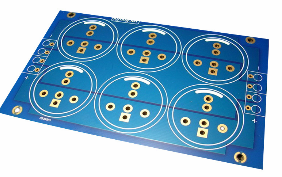In the process of PCB copying, there will be a situation that makes people feel dilemma. It is because the temperature and humidity are not properly controlled or the exposure machine heats up too high, which causes the film to deform. This is a dilemma. It is to continue, which affects the quality and Performance, or just discard it and cause cost loss? Here are a few ways to correct the deformed film.
1. Splicing method: This method is suitable for negatives with inconsistent lines and inconsistent deformation of the negatives of each layer, and it is particularly effective for the correction of the solder mask negatives and the negatives of the multi-layer board power layer. Specific operation: cut the deformed part of the negative film, re-splice it against the hole position of the drill test board, and then copy it. Of course, this is for the simple deformed line, large line width and spacing, and irregular deformation. ; Not applicable to negatives with high wire density, line width and spacing less than 0.2mm.
Warm reminder: When splicing, pay attention to minimize the damage to the wire and not to damage the pad. When revising the version after splicing and copying, pay attention to the correctness of the connection relationship.

2. Change the hole position method: This method is suitable for the correction of the film with dense lines or the uniform deformation of the film on each layer. Specific operation: first compare the negative film and the drilling test board, measure and record the length and width of the drilling test board respectively, and then adjust the hole on the digital programming instrument according to the two deformations of the length and width. Position, adjust the drilled test board to cater to the deformed negative. The advantage of this method is that it eliminates the troublesome work of editing negatives, and can ensure the integrity and accuracy of the graphics. The disadvantage is that the correction of the negative film with very serious local deformation and uneven deformation is not effective.
Warm reminder: To use this method, you must first master the operation of the digital programming instrument. After using the programming instrument to lengthen or shorten the hole positions, you should reset the out-of-tolerance hole positions to ensure accuracy.
3. Pad overlap method: This method is suitable for film with line width and spacing greater than 0.30mm, and the pattern lines are not too dense. Specific operation: enlarge the hole on the test board into a circuit piece with pads to overlap and deform to ensure the minimum ring width technical requirements.
Warm reminder: After overlapping copy, the pad is elliptical. After overlapping copy, the edge of the line and the disk will be halo and deformed. If the user has very strict requirements on the appearance of the PCB board, please use it with caution.
4. Photographic method: This method is only suitable for silver salt film. It can be used when it is inconvenient to re-drill the test board and the deformation ratio in the length and width directions of the film is the same. The operation is also very simple: just use the camera to enlarge or reduce the deformed graphics.
Warm reminder: Generally, the film loss is large, and it needs to be debugged many times to obtain a satisfactory circuit pattern. When taking pictures, the focus should be accurate to prevent the lines from being deformed.
5. Drying method: This method is suitable for the undeformed negative film, and can also prevent the negative film from deforming after copying. Specific operation: take the negative film out of the sealed bag before copying, and hang it under working environment conditions 4--8 For hours, let the negatives have been deformed before copying, then after copying, the probability of deformation is very small. For the film that has been deformed, other measures need to be taken.
Warm reminder: Because the film will change with the change of the environmental temperature and humidity, when hanging the film, make sure that the humidity and temperature of the hanging place is the same as that of the working place, and it needs to be in a ventilated and dark environment to prevent the film from suffering Pollution.
Of course, the above are all remedies after the film is deformed. PCB engineers should still consciously prevent the film from deforming. In the PCB copying process, the temperature is usually strictly controlled at 22±2 degree Celsius and the humidity is 55%±5%RH., Adopt cold light source or aerator with cooling device, and constantly replace the backup film.